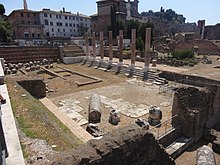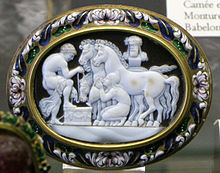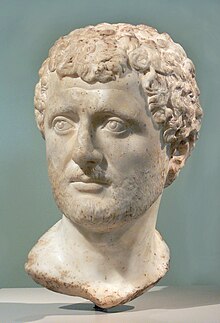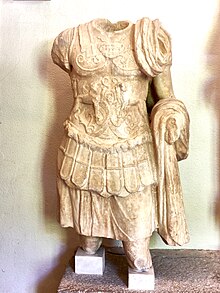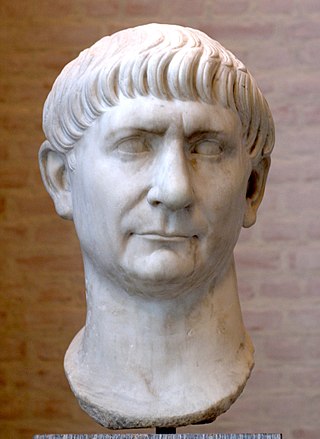
Trajan was a Roman emperor from AD 98 to 117, the second of the Five Good Emperors of the Nerva–Antonine dynasty. He was a philanthropic ruler and a successful soldier-emperor who led the Roman Empire to its greatest territorial extent by the time of his death. He was given the title of Optimus by the Roman Senate.
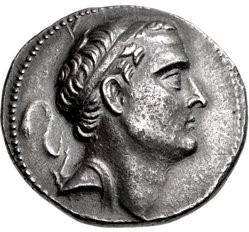
Seleucus IV Philopator, ruler of the Hellenistic Seleucid Empire, reigned from 187 BC to 175 BC over a realm consisting of Syria, Mesopotamia, Babylonia and Nearer Iran.
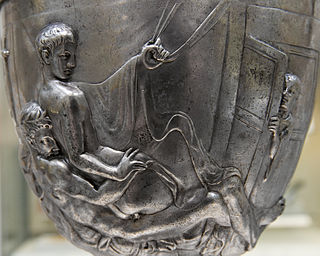
The Warren Cup is an ancient Greco-Roman silver drinking cup decorated in relief with two images of male same-sex acts. It was purchased by the British Museum for £1.8 million in 1999, the most expensive single purchase by the museum at that time. It is usually dated to the time of the Julio-Claudian dynasty.

The Temple of Jupiter Optimus Maximus, also known as the Temple of Jupiter Capitolinus, was the most important temple in Ancient Rome, located on the Capitoline Hill. It was surrounded by the Area Capitolina, a precinct where numerous shrines, altars, statues and victory trophies were displayed.

Nazi plunder was organized stealing of art and other items which occurred as a result of the organized looting of European countries during the time of the Nazi Party in Germany.

Repatriation is the return of the cultural property, often referring to ancient or looted art, to their country of origin or former owners.
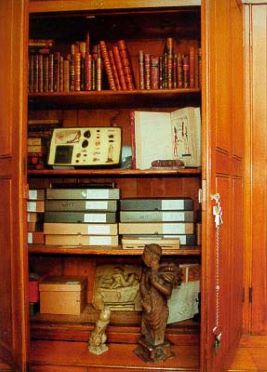
The Secretum was a British Museum collection that held artefacts and images deemed sexually graphic. Many of the items were amulets, charms and votive offerings, often from pre-Christian traditions, including the worship of Priapus, the Greco-Roman god of fertility and male genitalia. The segregation was probably on moral grounds, motivated by a paternalistic stance from the museum to keep what they considered morally dangerous material away from all except scholars.

The Comitium was the original open-air public meeting space of Ancient Rome, and had major religious and prophetic significance. The name comes from the Latin word for "assembly". The Comitium location at the northwest corner of the Roman Forum was later lost in the city's growth and development, but was rediscovered and excavated by archaeologists at the turn of the twentieth century. Some of Rome's earliest monuments; including the speaking platform known as the Rostra, the Columna Maenia, the Graecostasis and the Tabula Valeria were part of or associated with the Comitium.
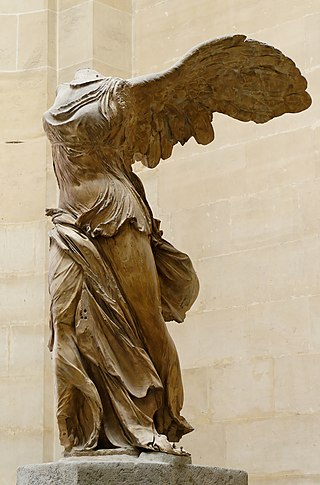
Hellenistic art is the art of the Hellenistic period generally taken to begin with the death of Alexander the Great in 323 BC and end with the conquest of the Greek world by the Romans, a process well underway by 146 BC, when the Greek mainland was taken, and essentially ending in 30 BC with the conquest of Ptolemaic Egypt following the Battle of Actium. A number of the best-known works of Greek sculpture belong to this period, including Laocoön and His Sons, Venus de Milo, and the Winged Victory of Samothrace. It follows the period of Classical Greek art, while the succeeding Greco-Roman art was very largely a continuation of Hellenistic trends.

Looted art has been a consequence of looting during war, natural disaster and riot for centuries. Looting of art, archaeology and other cultural property may be an opportunistic criminal act or may be a more organized case of unlawful or unethical pillage by the victor of a conflict. The term "looted art" reflects bias, and whether particular art has been taken legally or illegally is often the subject of conflicting laws and subjective interpretations of governments and people; use of the term "looted art" in reference to a particular art object implies that the art was taken illegally.
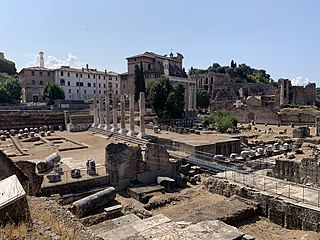
The Temple of Peace, also known as the Forum of Vespasian, was built in Rome in 71 AD under Emperor Vespasian in honour to Pax, the Roman goddess of peace. It faces the Velian Hill, toward the famous Colosseum, and was on the southeast side of the Argiletum.

The Resting Satyr or Leaning Satyr, also known as the Satyr anapauomenos is a statue type generally attributed to the ancient Greek sculptor Praxiteles. Some 115 examples of the type are known, of which the best known is in the Capitoline Museums.
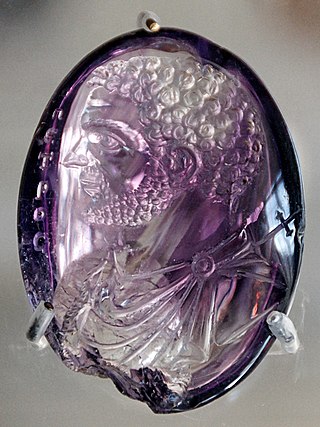
An engraved gem, frequently referred to as an intaglio, is a small and usually semi-precious gemstone that has been carved, in the Western tradition normally with images or inscriptions only on one face. The engraving of gemstones was a major luxury art form in the Ancient world, and an important one in some later periods.

In ancient Roman religion and myth, Hercules was venerated as a divinized hero and incorporated into the legends of Rome's founding. The Romans adapted Greek myths and the iconography of Heracles into their own literature and art, but the hero developed distinctly Roman characteristics. Some Greek sources as early as the 6th and 5th century BC gave Heracles Roman connections during his famous labors.

Fortuna Huiusce Diei was an aspect of the goddess Fortuna, known primarily for her temple in the Area Sacra di Largo Argentina at Rome. Cicero lists her among the deities who should be cultivated in his ideal state, because "she empowers each day". She thus embodies an important aspect of time as it figures in Roman religion: every day of the year had a distinct and potent nature, which the public priests were responsible for knowing and aligning the community with by means of the religious calendar.

Geneva Freeport is a warehouse complex in Geneva, Switzerland, for the storage of art and other valuables and collectibles. It is the oldest and largest freeport facility, and the one with the most artworks, with 40% of its collection being art with an estimated value of US$100 billion.
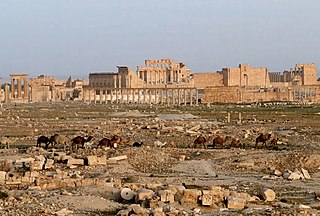
Palmyra is an ancient city in the eastern part of the Levant, now in the center of modern Syria. Archaeological finds date back to the Neolithic period, and documents first mention the city in the early second millennium BC. Palmyra changed hands on a number of occasions between different empires before becoming a subject of the Roman Empire in the first century AD.

The Mosaic Fragment with Man Leading a Giraffe is a mosaic from the 5th century CE, now held in the Art Institute of Chicago. The piece is Byzantine and originated in northern Syria or Lebanon. Mosaics of this type were commonly used to decorate wealthy family villas.
There were four primary kinds of taxation in ancient Rome: a cattle tax, a land tax, customs, and a tax on the profits of any profession. These taxes were typically collected by local aristocrats. The Roman state would set a fixed amount of money each region needed to provide in taxes, and the local officials would decide who paid the taxes and how much they paid. Once collected the taxes would be used to fund the military, create public works, establish trade networks, stimulate the economy, and to fund the cursus publicum.

The curator aedium sacrarum et operum locorumque publicorum was a political position in ancient Rome. The name translates to 'curator of sacred buildings and public works'. In surviving Roman inscriptions, the words aedium sacrarum are usually preceded by the word curator, but sometimes by resitutor or subcurator. The name utilized for this office was not officially standardized in ancient Rome. Inscriptions use any combination of the words curator, aedium sacrarum, et operum, locorumque publicorum, and populi Romani to refer to the office.
